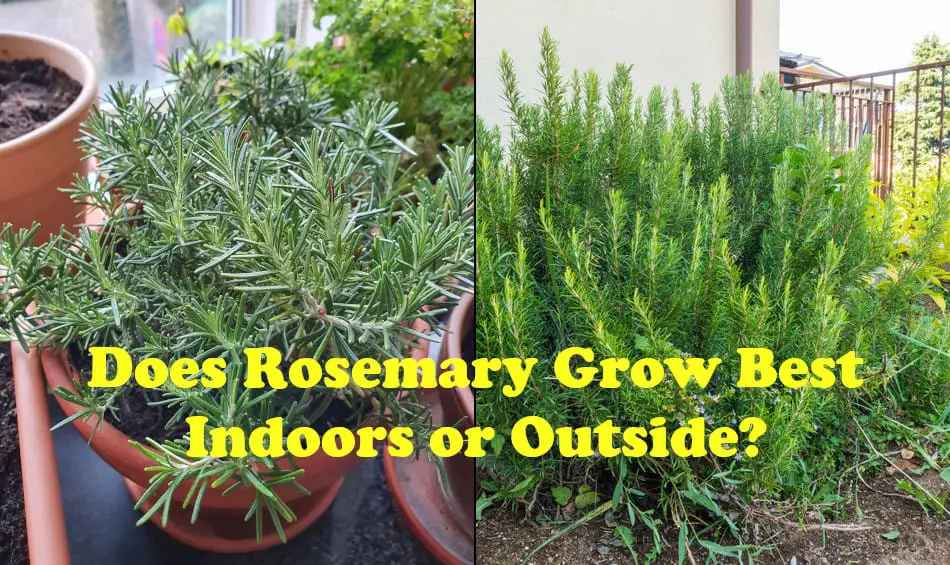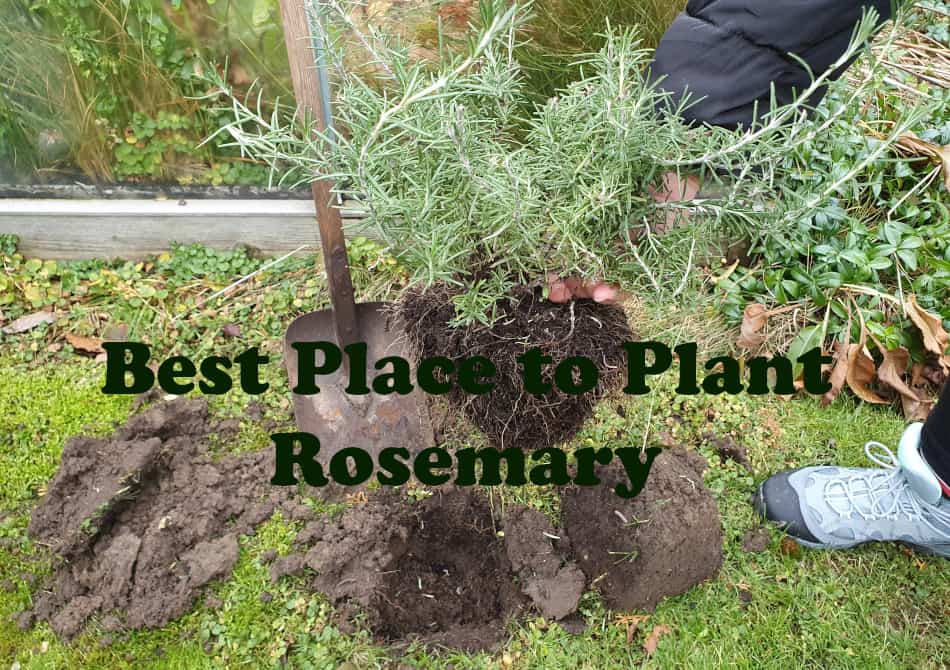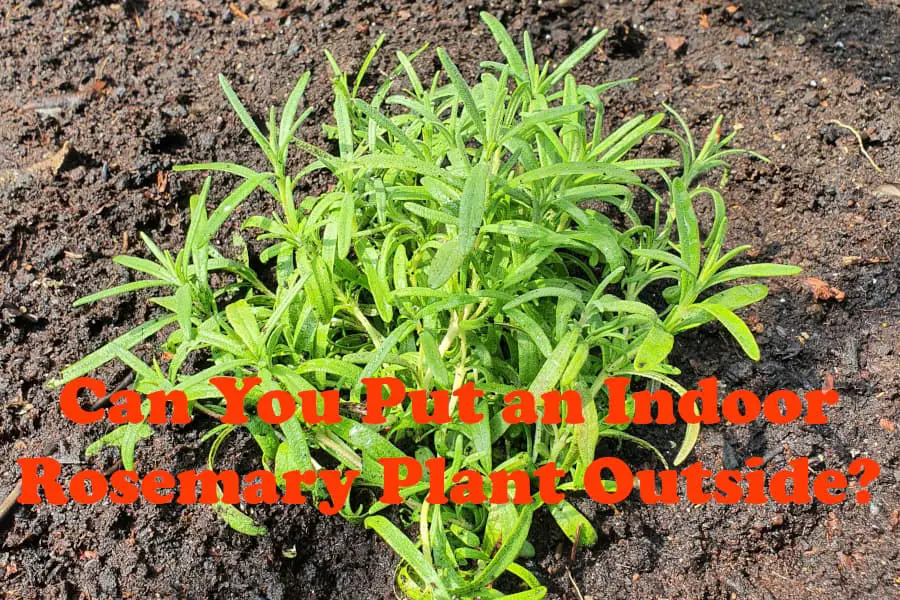Have you wondered if rosemary grows best indoors or outside? Maybe you are thinking about starting growing rosemary, or perhaps you already are. No matter where in the process of growing rosemary you are, this post covers everything you need to know about whether growing it indoors or outside is best for you.
As a general rule, rosemary grows better and gets bigger outside than indoors. Rosemary growing directly in the ground usually grows the best, but potted rosemary can also grow well both indoors and outside if the conditions are good.
Keep reading as I give a more detailed answer to help you decide if growing rosemary indoors or outside is best for you, as the answer is usually a bit more nuanced than just one or the other.

Does Rosemary Grow Best Indoors or Outside?
Rosemary plants are strong and can withstand a lot more than most other herbs. As long as the conditions are good enough, rosemary can grow and thrive both indoors and outside.
But which is better?
Rosemary that grows outside can generally grow faster and become bigger than rosemary that grows indoors. This is primarily because it can get a lot more sunlight outside and since there is also more room for the roots to grow and spread.
That being said, rosemary can also grow really well inside if you have a spot for it with a lot of sunlight, so in my opinion, the most important thing you need to consider is where you would prefer to have it.
If your goal is to get the biggest and most productive rosemary bush, you should definitely find a good spot for it outside in the ground where it is exposed to as much sunlight as possible. You can read more about how large rosemary can get and how to help it grow as large as possible on this link.
If you want to keep your rosemary plant in a pot, it is generally still better for it to be outside than indoors, as it can get more direct sunlight.
But if you want to have it in the kitchen or somewhere else inside, you can easily do that, and the plant will do just fine if it gets the sunlight and other conditions it needs.
Regardless of whether you are growing rosemary indoors or outside, your plant should have the following conditions to grow well:
- As much sunlight as possible (at least 6-8 hours per day in the summer).
- Warm temperatures in the summer (about 68-86°F or 20-30°C).
- Watering when the top 1-2 inches (2.5-5 cm) of the soil is dry.
- Well-drained, sandy soil. Ideally loam with about 40% sand content.
You can read more about giving rosemary the best conditions on this link, where I cover it in more detail.
Even though rosemary can grow really well both indoors and outside, there are, of course, advantages and disadvantages of both. Therefore, I have made a table to show them below, to help you decide if you want to grow rosemary indoors or outside.
Growing Rosemary Indoors vs. Outside: Pros and Cons of Both
Rosemary can grow really well both indoors and outside, and both ways have their advantages and disadvantages, so even though it would be easier to just say which is best, the answer is a bit more nuanced and depends on what you want from the plant.
I have made these two tables to show the advantages and disadvantages of growing rosemary indoors and outside.
Pros and cons of growing rosemary indoors:
| Advantages of growing rosemary indoors | Disadvantages of growing rosemary indoors |
| It is protected from frost and bad weather | It usually doesn’t get as large as outside |
| It is easy to control watering | It is less exposed to sunlight |
| It can be moved around as needed | It usually has less room for roots to grow |
| It is better protected from pests and diseases | It needs watering more frequently |
| It is easy to control soil content and pH | There is a higher risk of overwatering |
The key takeaway from this is that the primary advantages of growing rosemary indoors are that it is more protected from things such as frost and bad weather, pests, and diseases and that you can easier control the conditions such as watering and soil content.
The primary disadvantage of growing rosemary indoors is that it usually doesn’t grow as fast and get as big as outside. You can help your indoor plant to get bigger by giving it as much sunlight as possible and growing it in a large pot with plenty of room for the roots to grow and spread, as that will determine how big the plant itself can get. I recommend using pots that are at least 12 inches (30 cm) in diameter and height for rosemary.
Pros and cons of growing rosemary outside:
| Advantages of growing rosemary outside | Disadvantages of growing rosemary outside |
| It usually gets bigger than indoors | It is more exposed to frost and bad weather |
| It grows faster than indoors | It is difficult to control how much water it gets |
| It is more exposed to sunlight | It is more exposed to pests and diseases |
| There is more room for roots to grow | It cannot be moved easily (unless it is in a pot) |
| It can get older than indoor plants | |
| It needs watering more rarely | |
| It repels certain pests | |
| The flowers attract bees |
The key takeaway here is that rosemary plants that grow outside generally grow faster and can get much bigger than rosemary plants that grow indoors as they are exposed to more sunlight and have more room for the roots to grow. Rosemary plants growing outside also often get much older than indoor plants. You can read more about that here.
Plants that grow outside are naturally also more exposed to bad weather and frost in the winter as well as pests and insects, but the rougher conditions can also make the plant adapt to survive outside by becoming hardier.
Either way, I would honestly say that once you can ensure that your rosemary will get enough sunlight, the most important thing to consider when deciding whether to grow it inside or outside is what you want to do with the plant, but if you want the biggest, fastest-growing rosemary, you should grow it outside.
Regardless of whether you are growing rosemary indoors or outside, it is crucial that it gets the right conditions, and the best way to ensure that is to know how to find the best place for it. I cover what you need to know below.
Finding the Best Place for Rosemary: 5 Things to Remember

Whether you are about to start growing rosemary for the first time or already have been growing it for a while, perhaps the most important thing is knowing how to find the best place for your plant.
I actually had a great chat with a really helpful and extremely experienced gardener about this when I had to find the best place for my rosemary not that long ago, and she gave me some really good tips,
These tips are accurate regardless of whether you are growing rosemary indoors or outside and whether it is in a pot or the ground.
These are the six factors to keep in mind when deciding where to put your rosemary.
- Sunlight: Place your rosemary in a spot where it can get plenty of sunlight. The more the better. At least 6-8 hours of sunlight per day in the summer. More info on this link.
- Wind: Plant your rosemary in a place where it is shielded from wind. Ideally up against a wall that gets a lot of sunlight outside, or next to a window that gets a lot of sunlight inside.
- Soil: Rosemary prefers sandy soil or loam. Mix about 40% sand into your soil to create well-drained soil that rosemary can thrive in.
- Spacing: Plant rosemary plants 2-3 feet (about 60-90 cm) apart if grown in the ground. Potted rosemary can just be moved as needed, but make sure there is always air all the way around the plant.
- Pot vs. ground: Rosemary grows best in the ground, but can grow just fine in a big pot (at least 12 inches/60 cm height and width) if the other conditions are good.
I have written a post where I explain how to find the perfect spot for your rosemary in more detail. If that is relevant to you, I recommend reading it on this link.
Can Potted Rosemary Stay Outside?
A question I have seen multiple times online is whether you can keep a potted rosemary plant outside, and the answer is actually quite simple.
Potted rosemary can grow perfectly fine outside as long as it gets plenty of sunlight and space and grows in well-drained, sandy soil. An advantage of growing potted rosemary outside is that it can be moved around throughout the year to get as much sunlight as possible.
It can be a good idea to bring your potted rosemary inside during the winter to spare it for the coldest months and then bring it back outside in the spring. If you do this though, I recommend you keep reading here as I get into how to harden off your plant to prepare it for being outside.
The only thing that is really important to know about when growing potted rosemary (both indoors and outside) is that the pot should be big enough and have good enough drainage.
Most pots have one or more drainage holes at the bottom, and some are even made from a material that also allows the soil to “breathe” better. I use and recommend terra cotta pots with drainage holes at the bottom as they have both of these features. This is really important for rosemary to prevent overwatering and root rot (which you can read more about here).
Can You Grow Rosemary Indoors All Year?
One of the common concerns about growing rosemary indoors is that it won’t grow all year. Luckily, the truth is a bit different.
Rosemary can be grown both indoors and outside all year as long as it gets at least 6-8 hours of sunlight per day in the summer, grows in well-drained, sandy soil, and has enough room to grow.
So if you prefer to keep your rosemary indoors all year, that is no problem. It can even be beneficial for the plant in the winter as it doesn’t get exposed to frost, which it can survive but prefers to avoid.
Can You Put an Indoor Rosemary Plant Outside?

If you have a rosemary plant indoors and you are thinking about putting it outside, this is for you.
It is absolutely possible to take rosemary that is growing indoors and put it outside, but there are some things you should know to avoid shocking or otherwise damaging the plant.
When taking an indoor rosemary plant and putting it outside, it is important to harden it off by putting it outside gradually. Do so by taking the plant out for a few hours per day and then back inside. Gradually increase the amount of time it stays outside over the course of 3-4 weeks before leaving it outside.
To harden off the plant basically just means getting it used to a new environment. It is not really necessary in the summer as it is already warm and nice outside, but if you want to put it outside earlier in the year, it is a really good idea to do it gradually.
I have written another post to help you find the best time to put rosemary outside. I also describe the process of hardening off your plant more in that post. You can find it here.
If you don’t put your rosemary outside gradually to harden it off as described here, there is a risk that the plant will be damaged from the sudden change in its environment.
Can You Bring a Rosemary Plant Indoors From Outside?
Bringing a rosemary plant indoors from outside is usually easier than the other way around as the temperature inside is generally warmer and milder than outside.
Rosemary that grows outside can be taken inside at any time of the year. Potted rosemary is easy and can be moved directly, but rosemary growing in the ground needs to be dug up and transplanted to a large pot before being brought inside.
If you need to dig up your rosemary and put it in a pot so you can bring it inside, I recommend reading the article on this link, where I explain how to do it.
It is important to know that rosemary growing outside generally grows faster and gets bigger than rosemary growing inside, so unless it can get better conditions inside or you have another specific reason for moving it, I recommend not doing it.
Growing Rosemary in a Pot vs. In the Ground
Rosemary can grow really well both in a pot and in the ground, and there are, of course, advantages and disadvantages associated with both ways.
I have written a post where I specifically discuss and explain the advantages and disadvantages of growing rosemary in a pot and in the ground to help you determine which way is better for you. You can find that post on this link, but if you just want the most important points, I have included them here.
Growing rosemary in a pot – pros and cons
| Advantages | Disadvantages |
| It can be moved around easily if needed | It doesn’t get as large as if it grows in the ground |
| It is easier to avoid pests than if it grows in the ground | It grows slower than if it grows in the ground |
| It is easier to control watering than if it grows in the ground | It needs to be watered more often than if it grows in the ground |
| It is easy to control soil content and pH than if it grows in the ground | There is a higher risk of overwatering than if it grows in the ground |
Growing rosemary in the ground – pros and cons
| Advantages | Disadvantages |
| It can get larger than if it grows in a pot | It is difficult to move the plant |
| It grows faster than if it grows in a pot | It can be difficult to control how much water the plant gets |
| It will often get stronger than if it grows in a pot | It is more exposed to pests and diseases |
| It requires less maintenance than if it grows in a pot | It is more exposed to frost and bad weather |
| It can live for longer than if it grows in a pot |
In Conclusion: Does Rosemary Grow Best Indoors or Outside?
To round off this post, here are the concluding points about whether it is best to grow rosemary indoors or outside.
- Rosemary grows faster and gets bigger if it grows outside in the ground.
- Rosemary that grows outside is more exposed to frost, bad weather and certain pests and diseases, but also tends to become more hardy than rosemary growing indoors.
- Rosemary growing indoors is more protected from frost, bad weather and certain pests and diseases, but tends to grow slower than rosemary growing outside.
So if you want the biggest, fastest-growing rosemary, you should plant it outside directly in the ground, but if you prefer to have your rosemary indoors in a pot, that is totally fine as long as you place it in a sunny spot.
